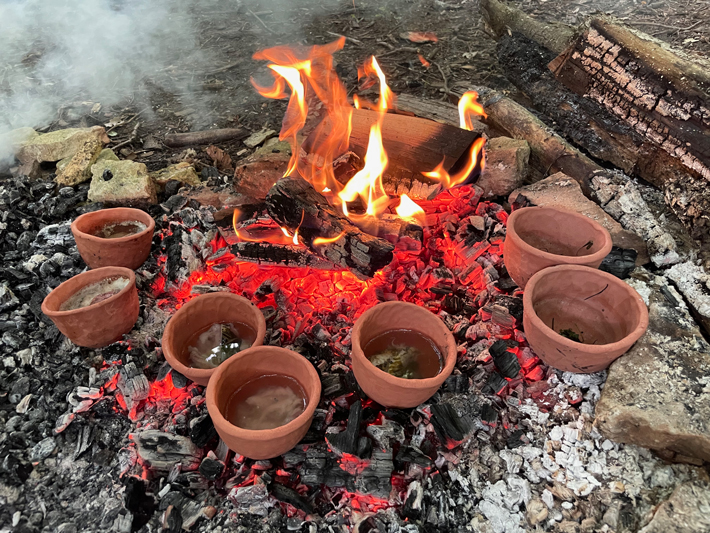Study Suggests Europe’s Hunter-Gatherers Produced Pottery

Broken, charred and still crusted with nearly 8000-year-old food, the remnants of ancient pottery found across northern Eurasia wouldn’t be mistaken for fine china.
But the advent of this durable technology—used to cook and store abundant plant and animal resources—was a huge step forward for hunter-gatherers in this part of the globe. It was also home-grown, new research suggests.
For decades, researchers believed pottery arrived in Europe along with agriculture and domesticated animals, as part of a “package” of technologies that spread northward from Anatolia beginning about 9000 years ago.
Pots found in Northern Europe dating around the same time were thought to be mere knockoffs by hunter-gatherers copying their more sophisticated farmer neighbors, says Thomas Terberger, an archaeologist at the University of Göttingen who was not involved with the new research. “A generation ago, nobody looked to the East.”
But a study published today in Nature Human Behaviour tells a different story. Beginning about 20,000 years ago, the know-how needed to make and use pottery spread among groups of hunter-gatherers in the Far East.
This containers replaced less durable vessels made of hide and skin, and were better able to withstand fire than wood bowls. Starting about 7900 years ago, clay pots became common from the Ural Mountains to southern Scandinavia within just a few centuries.
To map pottery’s spread, Rowan McLaughlin, an archaeologist at the National University of Ireland, Maynooth, and colleagues analyzed broken shards collected from 156 sites around the Baltic Sea and across the European part of the former Soviet Union—many stored in museums in modern-day Russia and Ukraine.
By sampling burned crusts of food stuck to the broken pots—remnants of bygone meals—they were able to get hundreds of new radiocarbon dates.
Fat residues revealed whether meat from ruminants like deer or cattle was on the menu, or whether people were boiling fish soup, pork, or plants instead. And comparing decorations and pot shapes helped the team map how pottery trends spread from community to community.
Though the raw material to make clay pots was widely available, the technical knowledge needed to shape and fire them must have been passed from person to person. New cooking and food preparation techniques had to be learned as well.
Put together, the data suggest pottery spread across parts of northern Eurasia rapidly, the team reports. Within a few hundred years, the technology swept north and west from the Caspian Sea, all the way to the eastern shore of the Baltic and southern Scandinavia.
The speed of the spread suggests potterymaking knowledge passed from group to group, rather than being introduced by new people migrating into the region. “There’s no way a population could grow that fast,” McLaughlin says.

Lucy Kubiak-Martens, an archaeobotanist at BIAX Consult, a commercial archaeology company in the Netherlands who was not involved with the paper, agrees with that interpretation. “It seems the knowledge traveled, not people,” she says.
If so, that would contrast with how similar technology spread out from Anatolia: Recent genetic evidence suggests that around the same time, farmers from Anatolia brought their own pottery styles and traditions with them as they expanded into southern Europe.
More research could help unravel exactly how it spread. For example, if hunter-gatherer societies were patrilocal—with women leaving home to marry men from other communities—“pottery could be a female craft that spread from village to village through marriage,” McLaughlin says.
The study provides evidence that hunter-gatherers were far more sophisticated than archaeologists once assumed, argues co-author Henny Piezonka, an archaeologist at Christian-Albrecht University of Kiel. In fact, she says, mobile hunter-gatherer societies from prehistoric Japan to the shores of the Baltic adopted new technologies without abandoning their roving lifestyles: Rather than being a step behind farmers, they were simply on a different path altogether.
“Hunter-gatherer societies are not backwards or simple, but were innovators in their own right,” Piezonka says.
The Iron Curtain, meanwhile, may have further obscured the narrative of prehistoric pottery’s spread west across Asia. “Hunter-gatherer pottery existed all along northern Eurasia for 10,000 years,” Piezonka says, “but the evidence was mostly published in Russian, and European archaeologists just didn’t know about it.” The result was a Euro-centric tale of triumphant farmers and pastoralists introducing important technologies to Europe, she says.
That began to change in the late 1990s, when researchers from Western Europe joined forces with colleagues in Russia, Ukraine, and the Baltics. The new study reflects this more recent legacy of collaboration. Submitted before Russia invaded Ukraine in February, it includes co-authors from Ukraine, Russia, and Belarus, although the authors say several Ukrainian scholars withdrew their names from the final publication to avoid copublishing with Russian academics.
“It’s a very nice example of how cooperation between colleagues in Eastern and Western Europe emerged in the last 20 years,” Terberger says. “It’s extremely sad all these contacts have been so damaged by the Russian war in Ukraine.”